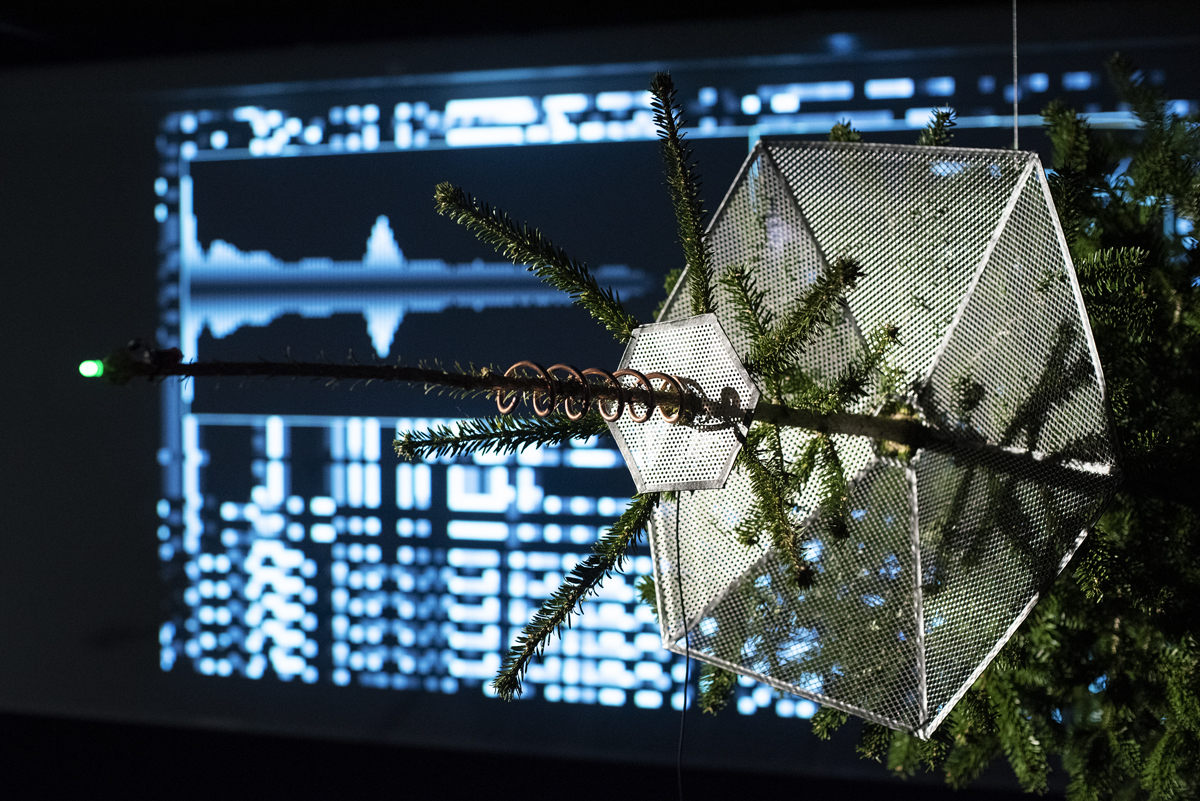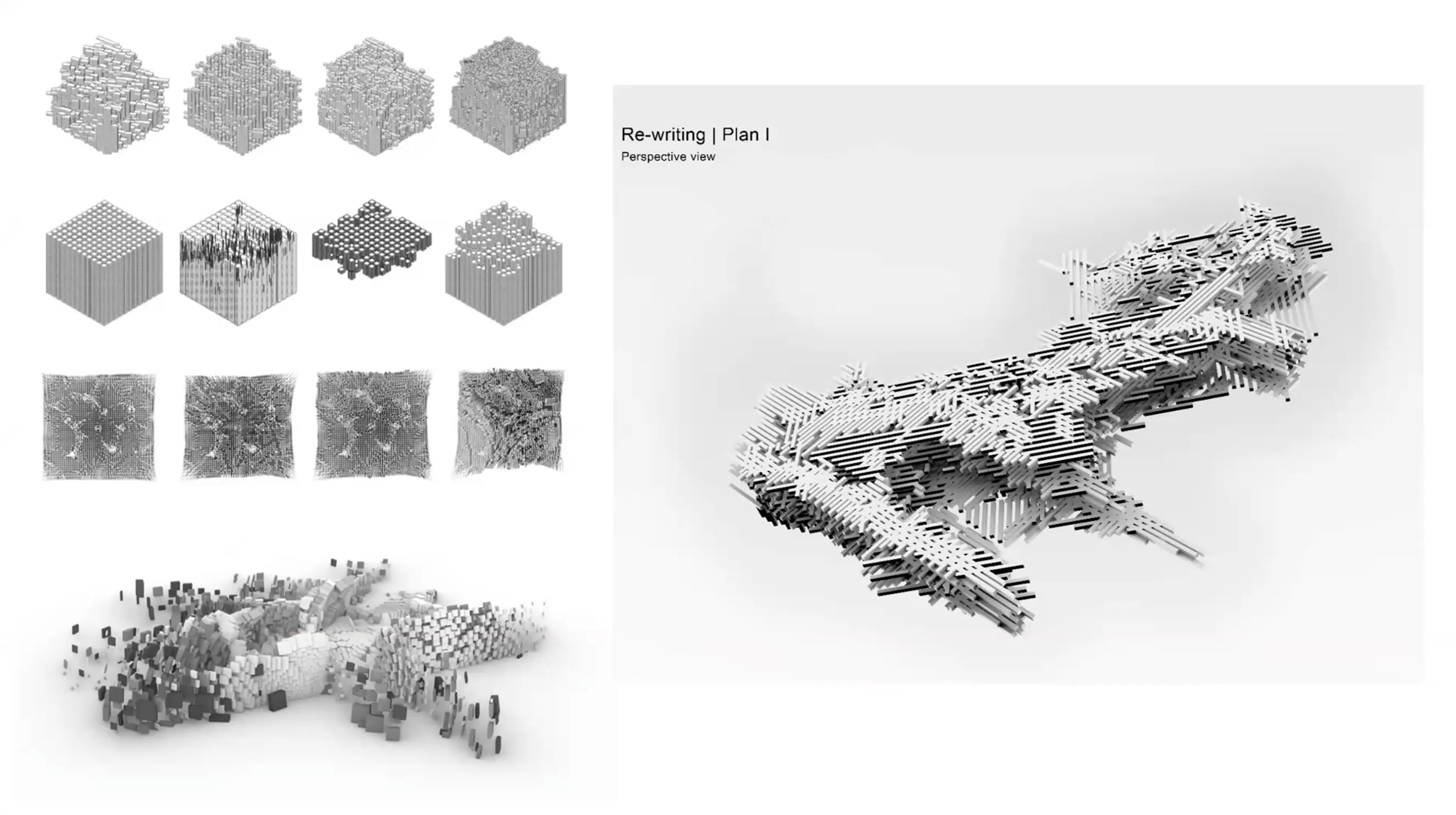Rewriting networks
The second workshop in Radio explorations explored the notion of rewriting in context of telecommunications and beyond: how to translate between domains, such as the natural environment and network infrastructures, digital and spatial, books and architecture. Three invited guests, Sarah Grant (Kunsthochschule Kassel), Roberto Bottazzi (The Bartlett) and Miro Roman (CAAD, ETHZ) presented their current research in nature of networks, cryptographic writing and the design of search. In the space that is marked by the three interests, the Radio explorations team presented the first data observatory, Codebook: reorganized archive of radio signal recordings, explored through text, topics and keywords identified in a statistical model (LDA) of signal descriptions. A prototype of the second data observatory, Projections was discussed in terms of rewriting radio signals through different domains, such as music or sounds of nature.
Sarah Grant: Antennas
Sarah grant is an artist working with networking technology and a professor for New Media at the Kunsthochschule Kassel. She discussed the way her experimental relationship to antennas, to radio waves and the electromagnetic spectrum informs her artistic practice. The experimental work with antennas as sculptures brings the material, situated aspect of radio signal transmission into this discussion, and reinvents the notion of efficiency in communication engineering. Exploring network infrastructure as biological hybrids, this work inscribes itself in wider questions of information transfer across different kinds of environments: electromagnetic landscapes, experiments with single-celled organisms, or public space.

LANscapes (2019), a working antenna sculpture, by Sarah Grant and Danja Vasiliev. Courtesy of Sarah Grant
The design of wearable reflective dishes for antenna-trees in Ljubljana emphasizes the interest in sculptural form, while preserving or reimagining its performance as technical infrastructure. It not only speaks to an idea of an antenna-tree, but also sees it through all the way to the end of actually working. What do we know and how do we organize this knowledge of telecommunications engineering, how antennas actually work and transmit information? Grant’s work brings some of this knowledge to attention in a way that is more visually appealing, in a different visual language, promoting reflection on these networks as part of ourselves, something we are born into and participating in.
Roberto Bottazzi: Rewriting
Roberto Bottazzi is an architect, researcher and Programme Director of the Master in Urban Design at the Bartlett school of Architecture in London. Bottazzi discussed design and use of computational techniques in context of knowledge discovery and classification, exposing the difference between searching and finding proof. He opened up the discussion on computation to rethinking computational techniques over a very large span of time, historically and materially. In this scope, Bottazzi developed the notion of cryptography as a way to translate across domains, a way to establish communication between different levels of transparency and things that are indeed fully opaque. This is based on the idea of the cipher, the bridge, or the tool to move between two domains. The cipher is not a natural system - it is designed, structured, and has a particular relationship to semantics. He compares Ramon Llull’s medieval work on the system of wheels, to encode a purely Christian metaphysics to the work of Pico della Mirandola, Giordano Bruno and Leibniz, as well as Giulio Camillo on the manipulation of symbols as a discovery technique. Llull is using the cypher to classify knowledge against combinatorial explosion, while the Renaissance thinkers engage with combinatorics as a method of search. Bottazzi brings these old examples in reflection on the contemporary moment in which he considers how we, in the best of neoplatonic traditions, find ourselves searching for something stable about the world in big data.
In search and classification, reduction and unbound search, ideas that emerge in the discipline of architecture could have resonance with the Radio Explorations project research agenda. The introduction of numerical processes fully changes the game for symbolic manipulations. The network of the cipher stands for the ability to get something known and something unknown to resonate with one another. This is the role that algorithms have, as for example the use of marching cubes algorithm in obtaining an image from an MRI scan. This process lets certain characters in the data emerge, we could say that it lets it speak.

Rewriting as a search mechanism in urban design. Courtesy of Roberto Bottazzi
Rewriting is about creating algorithmic cipher to overlay onto a certain dataset and let certain elements of the data set come through. How to engage with things that are beyond our immediate sensorial perception? By continuously retuning the two domains, we arrive at a point where we can construct a connection between the two. In his work with urban design, Bottazzi explores ways of investigating datasets in search for a particular aspect or a source of intuitions that he can take and play with. This work resonates strongly with problems encountered in Radio Explorations project, namely the ‘alienness’ of the domain of radio signals to human senses, the fact that they are beyond our sensory and cognitive capacities. Bottazzi proposes to think of this work as a cryptographic process of establishing communication across the two domains. It is about bringing together aspects of technology being in the environment and being instrumental to our exchanges, as highlighted by Sarah Grant, with the way to understand that which is already there through abstraction and cryptographic movement across the data that is always partial, but always considered as complete (such as the SIGID wiki archive of radio signals).
Miro Roman: SEARCHING
Miro Roman, architect and researcher working at the Digital Architectonics Chair of Professor Hovestadt in Zürich, ETHZ and our guest at the Technicity of Listening workshop presented a search engine, Ask Alice, which came out of his previous work with Alice as an avatar, a way to work with abundant streams of digital information. This work is primarily concerned with constitution of a database and the way to navigate it. To a search query, Ask Alice answers with a spectrum of possibilities and ways to look at things. Roman made a demonstration of his search engine in the context of radio signals, searching for it as a term and tracing ways to talk, or write, about it in someone else’s terms - Hofstadter, Latour, Asimov. Alice developed into different other characters, such as Homo Effluviens for a conference, or Think SOLL for a fashion brand, and continues to look for others.

